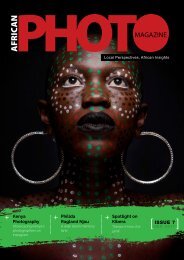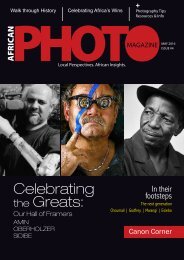African Photo Magazine Issue #6
This is the 6th issue of the Pan-African photography magazine, African Photo Magazine and the main showcase is Ghana Photography. Additionally, we showcase African photographers and visual artists showcased by Performa, Red Hook Labs and Nataal in 2017, in New York City.
This is the 6th issue of the Pan-African photography magazine, African Photo Magazine and the main showcase is Ghana Photography. Additionally, we showcase African photographers and visual artists showcased by Performa, Red Hook Labs and Nataal in 2017, in New York City.
Create successful ePaper yourself
Turn your PDF publications into a flip-book with our unique Google optimized e-Paper software.
Cultural Heritage Centre, Arusha Tanzania<br />
In almost all <strong>African</strong> societies,<br />
the most important role of women<br />
is to bear children. Whatever else<br />
– farming, cooking, or their role<br />
in women’s associations – their<br />
primary responsibility is to produce<br />
and nurture children. In many West<br />
<strong>African</strong> communities women are<br />
the most important members of the<br />
society in terms of magic power and<br />
statues glorify women. Women’s<br />
magic is demonstrable in the act of<br />
giving birth and as nurturer of life, just<br />
as her magic invigorates the magic of<br />
the earth. She represents the womb<br />
of the earth in which life and death<br />
repose. The female child is therefore<br />
also revered as a continuation of that<br />
legacy.<br />
In Defense of our<br />
Heritage<br />
s publishers of this magazine, we feel very deeply about cherishing our heritage as our past is what has<br />
forged our present and will mold our future. It is to this end we showcase our 2nd installment of artifacts<br />
from the Cultural Heritage Centre in Arusha, Tanzania, in celebration our <strong>African</strong> heritage and capturing it<br />
through the photographer’s lens. (<strong>Photo</strong>graphy Teddy Mitchener)<br />
A(See the 1st installment in issue #5 for the back-story on the Cultural Heritage Centre)<br />
The North East monsoon carried on its winds Arab trading dhows on an ancient sea route to the east coast of<br />
Africa and stashed away in holds of the exotic dhows were large numbers of elaborately decorated wooden boxes.<br />
These boxes, found all over bustling port cities where the Arabs traded and settled, were originally crafted by Indian<br />
carpenters. They were in great demand in the Arab world, as prized pieces of furniture, occupying the place of pride in<br />
homes. Over hundreds of years of migrations, the origins of the chests became blurred, as they began to be reproduced<br />
in the Arabian Gulf, and the coastal cities of East Africa. They were usually classified by their distinctive hasps, hinges,<br />
handles, wood and style of decoration.<br />
In Africa, south of the Sahara, wood<br />
is the natural material for carving. In<br />
the 20th century sculpture in wood<br />
is still very much a living tradition.<br />
Tribal carving was done for a clear<br />
and practical purpose. A figure may<br />
represent an ancestor, destined to<br />
stand in a shrine. A mask may be<br />
intended for use by a shaman just<br />
once a year in a special dance. A post<br />
may be designed to prop up a chief’s<br />
verandah or to form part of a palisade<br />
round his house. An elaborate chair is<br />
likely to be for the chief himself to sit<br />
on, and so on.<br />
The characteristic sculpture of<br />
Africa, which forms the largest part of<br />
what is usually considered primitive<br />
art, can be seen as early as 500 BC<br />
in the Nok culture - named from<br />
the village in Nigeria where pottery<br />
figures of this kind were first found.<br />
The Nok statuettes are mainly of<br />
human subjects. Made of terracotta,<br />
they combine strong formal elements<br />
with a complete disregard for precise<br />
anatomy. Their expressive quality<br />
places them unmistakably at the start<br />
of the <strong>African</strong> sculptural tradition.<br />
Traditional <strong>African</strong> birthing chairs<br />
were intended to provide balance and<br />
support to mothers giving birth. The<br />
birthing chairs supported the bottom<br />
of the women in labor and often have<br />
a slender, sloped back for comfort<br />
and to allow birthing assistants, who<br />
are positioned behind the mother<br />
in labor, to massage or support her.<br />
The chairs were usually only 8 to 10<br />
inches off the ground specifically to<br />
allow laboring women to brace their<br />
feet against the ground in a squatting<br />
position to help in pushing.<br />
ISSUE 6 JUNE 2017 9










